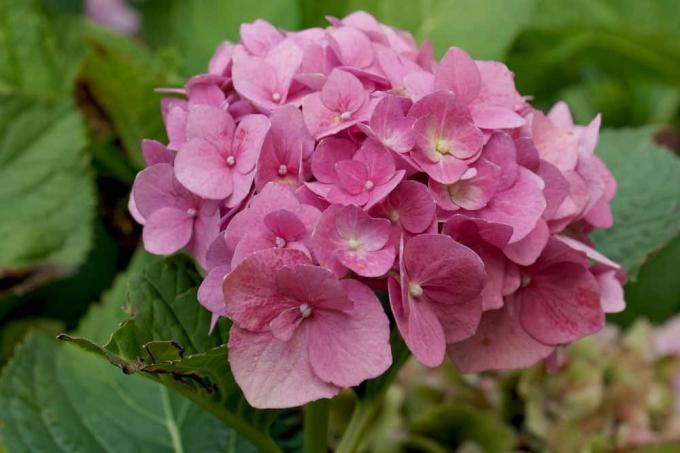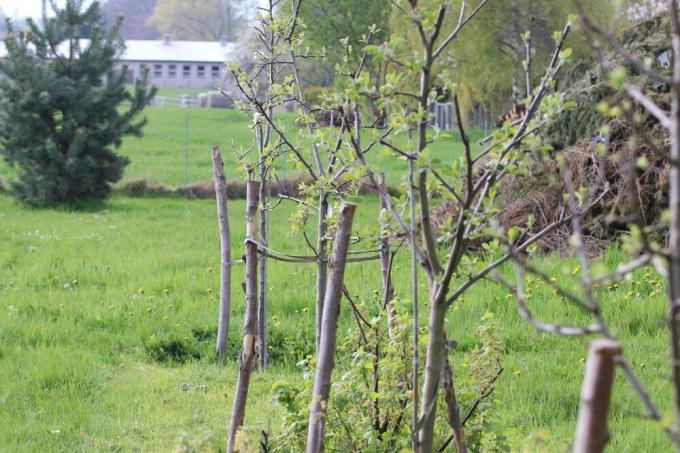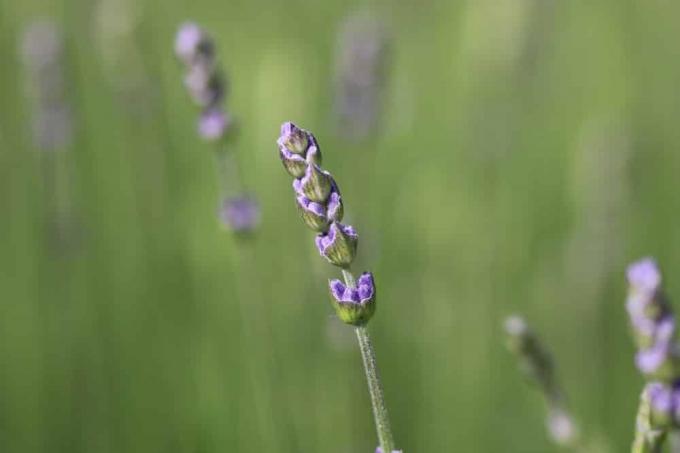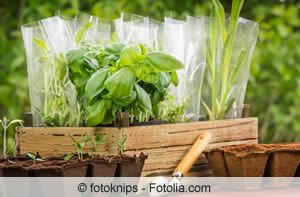

Table of contents
- Planting time according to plant qualities
- container goods
- Bare root goods
- bale goods
- Planting time by plant species
- Evergreen hedges
- Deciduous, deciduous hedges
- Observe legal regulations
- Conclusion
The popularity of hedge plants is due on the one hand to the huge selection of plants and on the other hand to their flexible application and design options. Hedge plants are divided into different categories, which differ depending on the plant species, their requirements in terms of location, soil and habitat and, last but not least, the right planting time. The latter depends on factors such as plant and Root quality, the plant species and the weather conditions, which have a significant influence on the growth and further development of the plants.
Planting time according to plant qualities
In principle, hedges can be planted in spring and autumn, the ground is frost-free and the plants have enough time to take root well in the ground before winter. Midsummer is completely unsuitable for planting. It is therefore recommended that the planting times be based on the respective plant qualities such as container goods, bare root or root ball goods.
container goods
There is no best time to plant container plants, they can be planted all year round provided the soil is frost free. This particularly long and flexible planting period is due to the fact that container plants are grown in the pot in which they are offered. They are well rooted and their root is undamaged. This makes these plants particularly resilient and one of the highest quality. Their probability of growth is almost 100%.
Even if container plants can generally be planted all year round, planting in spring is usually recommended. This has the advantage that the plants grow faster compared to bare-rooted plants. Planting in midsummer is generally not advisable, because evaporation occurs during this time over leaves and needles, due to the weather, is particularly high and, as a result, also the initial one maintenance effort.
Bare root goods
As a rule, only deciduous shrubs are offered bare-rooted. As a result, they are only commercially available during the leafless period, from around the end of October to the beginning of November and around mid-April. They should also be planted during this frost-free period.
- Bare-root goods are offered without soil balls, roots are practically bare
- Because of this, the planting period is very limited
- Plants can only store very little water
- Accordingly, plant as soon as possible after purchase
- Best planting time is in autumn
- Planting in the cooler season protects roots from drying out
- It is better to plant more frost-sensitive plants in spring
- So they can grow well until winter
Tip:
Longer storage is not recommended. If it is nevertheless unavoidable, you should make sure that bare-rooted plants are never stored unprotected from the sun and wind and only for a short time. The root should always be kept moist during this and not dry out.
bale goods
In contrast to bare-root plants, so-called bale goods are offered with a ball of earth that is tied into a fleece or ball cloth to prevent it from falling apart. In the case of larger plants, the bale is additionally covered with a wire mesh or wire mesh. equipped with a wire basket. These qualities have the advantage that the plants are supplied with nutrients for a certain time and therefore do not have to be planted immediately after purchase.

They can easily be stored for a few more days as long as they are supplied with sufficient water for the duration of storage. Balled crops are usually available in spring and autumn and should be planted then. The best time to plant is when the main growth phase is over, i.e. between the end of September and April/May. In exceptional cases, if the weather is cool, you can still plant in June or July.
Tip:
Planting after May always carries a certain risk, because the new shoots or the fresh leaves need a lot of water, which costs the plant the strength it actually needs to grow.
Planting time by plant species
Evergreen hedges
The best planting time for hedge plants is influenced not only by plant qualities, but also by whether they are evergreen or deciduous species. Conifers are also very popular as hedge plants. They are a subspecies of evergreen plants.
- Evergreen deciduous hedges are best planted between mid-September and mid-November
- The earlier you plant, the better they will survive the winter
- Soil is still quite warm in September, so that hedge plants take root better
- When planting in the fall, water on frost-free days in winter too
- Even in winter, these plants evaporate a lot of water through their leaves
- Plant evergreen, somewhat frost-sensitive shrubs preferably in spring
- These include, for example, rhododendron and cherry laurel
- Planting time for conifers in autumn and spring
- In autumn between September and November, in spring from March to April
The different planting times in autumn and spring have a decisive advantage for the respective plant species. If planted in autumn, the plants can take root well into the ground until winter and if planted in spring before the dry period. On the other hand, planting in midsummer and in winter is always discouraged.
Some of the most popular evergreen hedge plants include B. False cypress, tree of life, cherry laurel, yew, boxwood, medlar, common and hornbeam and field maple. Holly and firethorn also score with striking berry decorations in autumn.
Deciduous, deciduous hedges
Deciduous or deciduous hedges give the garden a special charm all year round. In spring with the fresh leaves, in summer with dense foliage and/or flowers and in autumn with colorful foliage and, depending on the plant species, bright berries. Since deciduous hedges are usually bare-root plants, the best is Time for planting, as already mentioned, during the frost-free period from October to November or from March until April.
Tip:
Before planting, it is advisable to prune or trim both the roots and the shoots. to shorten. This stimulates root growth and better branching. Don't forget to water after planting.
Observe legal regulations
Regardless of the right time to plant, when planting a hedge, the legal Regulations are taken into account to avoid trouble and disputes with neighbors or authorities go. The main concern here is compliance with minimum distances to neighboring private or public properties. In some cases, hedges may not exceed a certain size.

Precise information on the relevant regulations, e.g. with regard to border distances, can be obtained from the responsible city administrations or municipalities. It is best to draw up a planting plan in accordance with the current regulations before buying the plants. Among other things, the growth characteristics of the respective plant species, the annual growth and possible competition with neighboring plants should be taken into account.
Conclusion
Basically, the best time to plant a hedge depends on the time of year and the condition or soil. the quality of the plants. Most people recommend autumn planting over spring planting, especially for evergreen plants. An exception are some more frost-sensitive species, which should better be planted in spring. In order for the hedge to develop without restrictions, it is essential to observe the official regulations regarding border distances to neighboring properties. This is the only way to avoid trouble with neighbors and authorities.
 garden editorial
garden editorial I write about everything that interests me in my garden.
Learn more about planting times

When do you plant fruit trees? 7 tips for planting time
Fruit trees have different requirements when it comes to the ideal planting time. It is important to take differences into account and to meet the respective needs. With the right expert tips, it works without any problems.

Hydrangea planting time: when is it ideal?
When is the best time to plant hydrangeas? We get to the bottom of the question and present you with the advantages and disadvantages of each season!

Viticulture | When is the best time to plant vines?
The right planting time is an important milestone in successful viticulture. Don't guess anymore when to plant vines for a bounty of juicy grapes. Read all the information about the best time to plant wine here. This guide reveals why a distinction should be made between bare-root and potted vines when choosing the date.

When is the best time to plant trees? Information at the best time
There are many reasons to plant a tree, be it as a house tree, to provide shade, to harvest fruit or because of its very individual appearance. Trees offer a variety of design options and an unimagined diversity of species. The times at which they are offered in stores usually correspond to the planting times.

When to plant lavender? The ideal planting time is spring/autumn
Originally native to the western Mediterranean region, lavender has been unfolding its aromatic scent in domestic gardens for several centuries. Passionate hobby gardeners only have to pay a little attention to the planting in order to enjoy the easy-to-cultivate bushes for many years.

Best planting time for herbs in the garden and on the balcony
Freshly harvested herbs from our own cultivation are unsurpassed in aroma and taste. The key to a premium quality harvest is choosing the best time to plant the young plants in the ground. You can find out the best time to plant herbs in the garden and on the balcony here.

